THA M10: Production & Performance,
Moorpark College Theater, Professor John Loprieno
 Proposal:
Proposal: Performing Excerpts of our Theatre Productions
Student blog by David Faubion,
david_faubion1@my.vcccd.edu
14 May 2013 10:08 AM
Drawing larger Audiences to College Theatre
Performing Excerpts of Our Productions
Table of Topics
What is an Excerpt?
Venue and Stage for Excerpts:
Local Libraries • High Schools and Colleges
Library Learning Resource Center • Campus Center
Strolling Actors, Mobile Theater
Info-theater • Steps to Performing an Excerpt
Press release, social media contacts, posting fliers
Meet the Playwright • Actors • Director and Designers
Audience in Costume for a Ticket Discount • Costume Design Contest
Pass out Info about the Play • Sell Tickets to the Play at the Excerpt
Audience Survey
Photo/Video Events • Sneak Previews • Intramural Culture
Catering Theater • Site-specific Theatre
Survey for Theater Art Majors
An excerpt of a play is
- A scene that is five to twelve minutes of performance time;
- An actor, although preferably two or more;
- Actors in costume as noted in the script or via the designer’s analysis
- A plain black portable backdrop, though preferably with some identifying feature(s) of the scene, and
- Managed by a traveling stage manager who will
- Place the backdrop
- Set up a portable PA and microphones
- Play the part of the dramatist playwright
- Introduce the excerpt • Talk to the audience
- Pass out info about the play, special offers and features
- Sell tickets • Strike the set.
Venue stages: Local Libraries

The Public Library in Thousand Oaks, CA is ten minutes south of Moorpark College. The library has ample outdoor space for theater of the excerpt, skit or snippet. It is a public library with a long, robust history of performance art.
The Public Library in Simi Valley with its spacious courtyards, performance stages; it awaits excerpts of the Moorpark College Theater of enactments the human experience, in harmony and reflection.
Ample outdoor space in front of the Reagan Library would attract tourists to the entrepreneurial spirit of Moorpark College Theater.
Venue stages: Area High Schools, Colleges and Universities
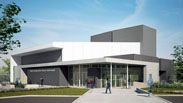
 Ample spaces for the quick, repeat
snippet shows at, e.g., Thousand Oaks
Ample spaces for the quick, repeat
snippet shows at, e.g., Thousand Oaks
High School & Santa Susana High School
 |
The Statue on Pavilion
to Martin Luther at CLU |
 |
Entrance to the
Performing Arts Center at CLU |
Venue stage: Moorpark College outdoor Theater-in-the-Round:
 |
| The Round: a mini theater-in-the-round @ the PAC |
(The Round) is a most apropos venue for the debut of an excerpt for MC Theatre productions. It is the round, smooth concrete plaza-like space before the main entrance of the Performing Arts Center. The Round is front and center just before the walkway around the PAC. The plaza-like space is bounded by a concrete wall: 2’ feet high by 18” wide, which may seat an audience as it defines the stage. Other layers of audience can stand behind the seated front tier. The Round can serve as a rehearsal space for the excerpt performances and as a debut venue. for all the MC performances, which might include dance and music. In addition, the Round space harbors the sandwich board: the portable marquis announcing the next billed performance; this lends an apropos segue to our excerpts as the live, real time announcement of the production and its performance.
Venue stage: College Library (LRC) and Fountain Hall
 |
| Library Learning Resource Center |
This prime real space is the next viable and useful venue for staging excerpts on campus. The heavy traffic and ample space twixt LRC and FH is augmented with walkways that serve as alternate routes to and from the main foot path across the foot bridge (west of the LRC and FH). Students will have ample space and efficient exit routes into the LRC and FH. The LRC venue will require our coordination with MC Campus Management, Security and Maintenance. The central location and big foot traffic makes it worthwhile.
Venue stage: the College Campus Center:
 |
| Moorpark College Campus Center |
The outdoor space in front of CC is the third most trafficked site on campus. The CC has a food court, bookstore, Student Activities Office, Associated Students, the Career Training Center and copy center. Morning and noon hours brings the heaviest traffic of students and staff. Our theatre stage manager with actor in costume can announce the excerpt in the cafeteria, “Come, one and all. Join us as we enjoy a prime sample of the Moorpark College Theatre!”
Strolling and Mobile Theater
A sequential route of our strolling theater on campus might be this route: from Applied Arts, to the Child Development Center, to the Gym, to the Academic Center, to the Humanities and Social Science Building, to the Music Building, to EATM, thru the PA lot, past the Communications Building and onto each successive building to the MC Observatory for a starry photo/ video event. The tradition of strolling theater art is a rich one, as noted in this outline of the art:
Who were the strolling players? In Tudor England, groups of strolling players tour the country performing plays in barns and the courtyards of inns. A most popular subject of these plays is the story of Robin Hood. The English government disapproves of strolling players fearing that strolling players spread disease like the plague; so, in 1572 a law bans strolling players from touring the country.
 |
| The strolling theater play, Louisa`s Walk |
Louisa`s Walk is a example of a the dramatic form:
strolling theatre. The play takes form from the genre of
convict drama in Tasmania. The play is set in and around a prison in Tasmania: the Cascade Female Factory. It is live theatre that takes audiences into the heart of a story about an Irish convict—Louisa Regan. As Louisa tells her story, the audience learns about her arrest, conviction and transfer to Van Diemen`s Land, under harsh conditions replicated for the audience to see. (In 1841, Louisa served a 7-year term for theft: a loaf of bread.)
Info Theater: Educational Theater
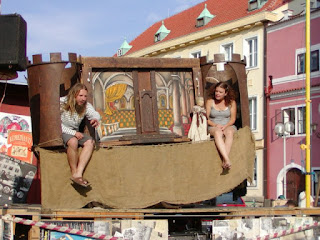
Theater is teaching tool. Educational theater, especially with themes of social science, is on the rise in the California public school system. For example, the history of the UFW and Cesar Chavez is presented by a three distinct theater companies into CA schools. Local high school and college indoor and outdoor stages, gazebos and classrooms for theater and history are settings for a portable and efficient and topical presentations. Libraries and other public institutions present venues new opportunities for our additional public exposure. Institutions present viable venues such as hospitals, government functions, NGO, fund-raisers, fraternity sororities and civic groups such as the Rotarian, Toastmasters and arts boards, patrons and other advocates of learning and enterprise. All the world is a stage, so stages are limited only by imagination and distance from an audience.
Steps to Performing an Excerpt:
- Ask and enlist the actors in production to allocate more of their time;
- Create an apropos backdrop, if necessary and/or advantageous;
- Secure and test a PA system
- Rehearse the excerpt as needed
- Coordinate the special offers and features of the excerpt, and
- Verify the availability of tickets for sale
- Communicate to the College Administration for clearance and coordination with security and grounds and maintenance;
- Establish a two-way calendar of play dates based on what the College can permit and what the production actors can commit to;
- Circulate a sign-up sheet of actor commitment to a specific date;
- Give extra-credit to actors in performance and production classes;
- Coordinate more than one excerpt when actors with characters from other scenes in the step up to participate;
Press Release, Social Media and Fliers:
 |
| Social Media collage |
Before each excerpt show will bring more attention to our excerpt and strolling theater presence; so we want to inform our local media outlets, such as:
• The Moorpark College student newspaper: The Voice
• The Acorn and the Ventura County Star
• Sandwich-board posters
• Fliers on bulletin-boards and posting walls on campus
• Internet-based outreach in social media, and
• The College Theater web pages, which have issues such as dead links, poor navigation and lack of content that should be present. A high quality photo of the actor(s) in excerpt rehearsal and quotes from the director, the actors and the costume designer will all reflect the effort on a flier, in press and web releases. Authorization to post flier ought to be obtained, which for best results will be two weeks in advance of the excerpt show.
Meet the Playwright

This feature can open and/or close an excerpt. Meet the Playwright can also be a
coming attraction: a feature noted on the flier of the full production to come. A virtual Meet the Playwright might just be a document with photos, paintings or video of the actual dramatist and/or an actor in full costume and makeup. The stage manager can act the playwright, which will add to the value of the excerpt and the process of the playwright in the theater; it brings a contextual significance to the specific art form of the particular dramatist playwright and the idea of theater in general. There is much critical theater review as interviews of playwrights about their works, creative process and views of the world. Biographies, historical archives and Internet resources form an accurate image of the playwright.
Contemporary Strolling and Mobile Theater
 |
Twelfth Night strolls thru Central Park,
played by the NYC Classical Theatre |
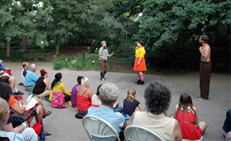 |
The Legend of Sleepy Hollow,
by Theater Hikes in Colorado |
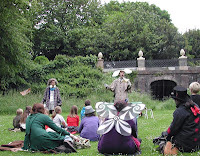 |
Down the Rabbit Hole,
by the Skew Bald Theatre, UK |
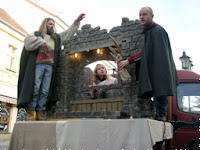 |
Theater on wheels blitzes thru
Prague, with an unknown play |
Meet the Actors
 |
Sir Andrew Aguecheek
of Twelfth Night |
After each excerpt, audiences have the chance to meet the actors. The excerpt in the unique venue and form of the show gives both audience and actor a sense of inter-personal connection, a shared affinity and new perspectives about theater, about the audience relationship to the play production and about the actor in relation to the character portrayed. An excerpt, like full -length play, has a
post-play discussion, Therefore, rather than inhibiting the audience’s
willful suspension of disbelief, the post-play meet-up
conditions an audience into a deeper level of intent for and commitment to plot, character and meaning.
Meet the Director and Designers:

This offers more of a potential area of interest for the avid theater fans. Others may have an interest in what make theatre tick, but need more of a connection to how it works. Onlookers will become an audience in the theatre house whenever directors unravels the mystery of their process of theatre. This is especially true if the puzzle resolves via the Q&A. Even having the director’s answers to FAQ will help establish an insider relationship with the public, such as:
• Making analogies to teaching, parenting and administration will help the general public gain a sense of the recent role of the director in the theatre.
• Personalizing the directorial art and the practice of it with the director’s brief biography and overview of theory and process will create an affinity and interest.
• Having that information in a hand-out form, even on digital video will draw audience from onlookers.
Audience in Costume for Ticket Discounts:
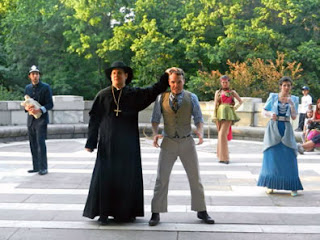 |
Comedy of Errors staged in
Riverside Park, NYC |
The excerpt has actors in full costume but no scenery and makeup, except in some circumstances. Therefore, the costume designer for our theatre may bring the most value to the excerpt in terms of an
explanation of the design element of costume: scenery for the body of the actor. The costume designers of the production and the Moorpark College Professor of Costume Design may choose to adjudicate the awarding of a ticket discount for audience members who choose to dress in apparel/ costume apropos for the period of social context of the play. How much of a discount based on what criteria will be left in the hands of the MC Theatre costume design staff. The criteria for the discounts as they apply to the levels of discount will be made available for individual and public use.
Costume Design Contest
 |
| Down the Rabbit Hole |
In addition to ticket discounts, the Professor of Costume Design can determine an overall winner of a costume design for 1) one or more characters in the play, and 2) a general citizen in the context of the play, or 3) a novel character —created by the designer, yet in the context of the play, as a design made and modeled by an audience member might be awarded. The prize granted could be tickets to current and future shows. A nice photo-op for a further promotion of MC Theatre Art in press and media releases will add value to the experience of the play production and performances.
Pass out Info about the Play and Production
 |
| Down the Rabbit Hole |
The stage hand/ manager and actors can hand out leaflets that include: the dates and times of each performance; • tickets at the PAC box office, online and at the event; • info about the ticket discounts for apropos period apparel—with the criteria for the apparel and view of it; • info about a costume design contest.
Sell tickets: Having a table with tickets to every performance of the play will help to sell them—to buyers who are enthused by what they have seen. Have sign-up sheets for email notices, the costume design contest and other incentives. In fact, having a formal guest book will show the public a level of sincerity and dedication, which the public will respect as a model of commitment and intent.
Theater Audience Survey
As the audience, your
preferences, your
critique and your
wish list for theater are key. A survey that asks the key questions about live theater may bring you a sense of interaction, engagement and more sincerity. Here is the start of a dialog between the audience and the theater as a whole:
- How often do you attend a live theatre performance?
- What would help you attend more often?
- More performances available for each play
- Reminders in the form of email and/or telephone calls
- A virtual live local theatre as podcast of through your computer
- Do you prefer live theatre over movies in cinema houses on your digital device or TV?
- What do you like about live theatre?
- The natural three dimensions
- An overall intimacy and the realistic sense of a present place and moment
- An in-the-moment immediacy of the performance arts, sports and living
- A sense of belonging to a community of neighbors attending the theatre.
- The post-play dialog about the play with other audience, cast and theatre staff.
- An escape from contemporary culture into a historical era
- A greater potential for a learning/ entertaining experience
- A play that immerses you into a play with current themes of current events
- The intermission between acts or billings of one act play
- In college and community theatre, having the possibility of knowing the actors in the context of daily life
- What qualities do you like in movies at a cinema house that live theatre doesn’t have?
- Detachment from the characters and action as they are preset and fixed
- Credits on screen, movie trailers and a constant access to concessions (snacks)
- The less formal mood, which allows more likelihood of disruptive, careless acts
- More detachment from others in the audience, which cinema yields to, and
- The first-run sense the current of cultural immediacy, thus being connected with your contemporaries in a shared experience, as a trend art.
Photo/ video events
 |
| The Globe Theater, an open-air theater |
All the world’s a stage The success of Shakespeare’s company: The King’s Men extends well beyond the confines of the Globe Theatre. In fact, the outreach throughout the UK and Western Europe is a major factor that establishes the reputation of The King’s Men, which in turn draws a large audience to the Globe Theatre—the home base of the growing legendary players. The King’s Men toured long and often to perform in royal and noble courts, in Coventry, fairs, inns and town plazas in throughout Britain and Europe.
Sneak Previews and Theater Trailers
 |
| The Round at the College PAC |
We can present excerpts of our productions as a live theatre trailer or as sneak theatre previews. For example, the MC THA One Act plays might be previewed, 1) just prior to the opening curtain of a main stage play, 2) during the intermission, 3) after the performance in the lobby of the house, 4) after other performance events such as dance, music, speech and sports, and 5) Filmed at The Round for display on the MC web site and on the closed-circuit TV system throughout the campus.
Intramural College Culture
Moorpark College has a vibrant culture of performance arts, clubs and sporting events. MC Theater might present previews prior to events, at intermissions, during half-times and after the performances of dance and music. These interactions are untapped force multipliers for all involved.
Catering Theater Performance
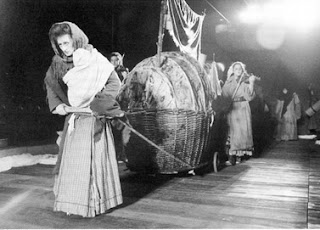 |
Players and wagon in an adaptation of The Taming of the Shrew
by The Royal Shakespeare Company’s Regional Tour in 1985 |
Local community music and dance ensembles often cater their variety of repertoire to various locales. The major theater companies in large cities book extensive tours, national and international. Still, the idea and practice of catering
short-piece theatre on the local level is untapped; it can include
custom ordered plot and story specific to the context of the client's group or event. Examples include:1) a group may want to enact the story of their founding and growth as a group, 2) an instructional and educational theatre, and special interest theatricals such as tributes, PSA and motivational theater.
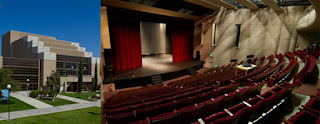 |
Moorpark College Performing Art Center,
the stage and the house |
Likely, most catered theatre would be pure entertainment; thus, a portfolio of examples on online digital video would be essential to promote the catering theater venture. Likewise, we can tour our short pieces and excerpts to the CLU and CSUN shows; we can perform previews 1). Just before each show either in the lobby of the main stage, 2) during the intermissions and/ or 3) after the shows. The fact that dance, music, speech and theater are the performance arts makes the intermingling a mutual net gain. It will serve as a synergistic bridge twixt the performance arts. The bridge can span into the athletic arts with the same effortless, natural and poignant convergence; Aristotle, who wrote Poetics about the dramatic art, would endorse and urge a robust convergence of the arts in theater forward to a new human mentality.
Survey for Theater Arts majors:
- Do you believe there is a need for growth in the creativity of and approach to theater?
- Do you believe there are new/ obscure creative types of theater to be realized?
- If you have ideas and practice, how would you improve and expand live theater?
- How would you improve and expand the study of Theater Arts?
- What area of Theater is your focus of study and career goal? Please check your main interest, if possible.
- Technical theater, in general
- Acting
- Do you have more than one main area of interest and focus?
- Technical theater, in general
- Acting
- How early in your academic life did you plan and/or aspire to become for a career in Theatre Arts?
- Grade school
- Middle school
- High school
- College
- Are you optimistic about the prospects of a secure career in Theater Arts?
- I am confident that theater will thrive
- 50/50, ambivalent
- Gloomy, yet your love of theater prevails
- It doesn’t bother you, as you love the art
Your comments:
- Do the examples of theater that you see encourage you in terms of the quality of the production, performance and attendance?
- Yes, nearly all
- 50/50
- No, nearly all
Comments:
- Do you believe that live theater can compete with other forms, such as movies, digital media and live performance arts such as music and dance?
- Yes
- No
- Maybe, but with changes
- If your sense is "Maybe, but with changes," do you have ideas/practice about how live theater can be improved/expanded to help it compete?
- Yes, I have ideas/ practice about how to improve theater
- No
Site-specific Theater
 |
| Theatricum Botanicum outdoors and inspired |
Site-specific theater is a production designed to be performed at a modified, unique location, instead of a standard theatre. Thus, a specific site may be built without any intention of serving a theatrical purpose; examples might include a hotel courtyard and converted buildings; or, it may be an unconventional theatre space, e.g., a natural setting or a historical outdoor site.
A performance becomes
environmental theatre when the location is meant to imitate, or is, the setting of the theatrical story; this is common with site-specific theatre, which is more interactive and informal than conventional theatre and in which a preexisting production is placed in an environment similar to the one in which the play is set (e.g. performing Hamlet in
a Danish castle) or
A Midsummer Nights Dream in a forest. A theater performance becomes
promenade theatre with the expectation of audience members walking or moving about, rather than sitting. The audience stand and walk about rather than sit, watching the action happening among them and even following the performers around the performance space. An example of promenade theater is the performances put on by Punchdrunk, a UK based theatre company, such as
Sleep No More. Another sense of environmental theatre is a production that brings the audience closer to the performance by moving the action off the stage area into the aisles. In a black box theater, acting platforms may even be built between sections of audience seats. In the ultimate presentational mode of theater, a performer will talk to, or otherwise involve an audience member in a scene. It is real audience member, as in interactive theater, or an actor planted to appear as an audience member. The traveling productions of the theatre troupe:
Ten Thousand Things Some select examples of site-specific theatre include these troupes:
 |
A Midsummer Nights Dream, a
musical adaptation by the Little Brown Theatre |
































